Lead-Antimony Sulfosalts from Tuscany (Italy). XX. Members of the Jordanite–Geocronite Series from the Pollone Mine, Valdicastello Carducci: Occurrence and Crystal Structures
Abstract
:1. Introduction
2. Geological Setting and Occurrences of Members of the Jordanite–Geocronite Series
3. Chemical Data
4. Crystallography
5. Crystal Structure Description
6. Discussion
6.1. Crystal-Chemistry of the Jordanite–Geocronite Isotypic Series from the Pollone Mine
6.2. Definition of Jordanite and Geocronite
6.3. New Insights on the Evolution of Pollone Deposit
7. Conclusions
Supplementary Materials
Acknowledgments
Author Contributions
Conflicts of Interest
References
- Walia, D.S.; Chang, L.L.Y. Investigations in the system PbS–Sb2S3–As2S3 and PbS–Bi2S3–As2S3. Can. Mineral. 1973, 12, 113–119. [Google Scholar]
- Vom Rath, G. Mineralogische mittheilungen. III. Der jordanit. Ann. Phys. Chem. 1864, 122, 371–408. [Google Scholar] [CrossRef]
- Kerndt, T. Über die Krystallform und die chemische Zusammensetzung des Geo-Kronits von Val di Castello. Ann. Phys. 1845, 141, 302–307. (In German) [Google Scholar] [CrossRef]
- D’Achiardi, A. Mineralogia della Toscana; Tipografia Nistri: Pisa, Italy, 1872; Volume II, p. 366. [Google Scholar]
- D’Achiardi, G. Geocronite di Val di Castello presso Pietrasanta (Toscana). Atti Soc. Toscana Sci. Nat. Mem. 1902, 18, 35–48. (In Italian) [Google Scholar]
- Solly, R.H.; Jackson, H. Sulpharsenites of lead from the Binnenthal. Part I. General description and chemical analyses, with a crystallographic account of jordanite. Mineral. Mag. 1900, 12, 282–297. [Google Scholar] [CrossRef]
- Amodio Morelli, L.; Menchetti, S. Su alcuni minerali della zona del Bottino e del Canale dell’Angina-Zulfello, Alpi Apuane. Atti Soc. Toscana Sci. Nat. Mem. 1969, 76, 417–445. (In Italian) [Google Scholar]
- Carmignani, L.; Dessau, G.; Duchi, G. I giacimenti a barite, pirite e ossidi di ferro delle Alpi Apuane. Studio minerogenetico e strutturale. Nuove osservazioni sui giacimenti polimetallici. Boll. Soc. Geol. Ital. 1976, 95, 1009–1061. (In Italian) [Google Scholar]
- Costagliola, P.; Benvenuti, M.; Lattanzi, P.; Tanelli, G. Metamorphogenic barite-pyrite (Pb-Zn-Ag) veins at Pollone, Apuane Alps, Tuscany: Vein geometry, geothermobarometry, fluid inclusions and geochemistry. Mineral. Petrol. 1998, 62, 29–60. [Google Scholar] [CrossRef]
- Carmignani, L.; Dessau, G.; Duchi, G. Una mineralizzazione sin-tettonica: II giacimento di Valdicastello (Alpi Apuane). Rapporti tra tettonica e minerogenesi in Toscana. Boll. Soc. Geol. Ital. 1975, 24, 725–758. (In Italian) [Google Scholar]
- Frizzo, P.; Simone, S. Diaphorite in the Pollone ore deposit (Apuan Alps, Tuscany, Italy). Eur. J. Mineral. 1995, 7, 705–708. [Google Scholar]
- Biagioni, C.; Orlandi, P.; Moëlo, Y.; Pardini, S.; Passarino, G. Sterryite e parasterryite. I solfosali aciculari di piombo e argento della miniera del Pollone (Pietrasanta, Lucca). Riv. Mineral. Ital. 2012, 36, 76–91. (In Italian) [Google Scholar]
- Bruker AXS Inc. APEX 2. In Bruker Advanced X-Ray Solutions; Bruker AXS Inc.: Madison, WI, USA, 2004. [Google Scholar]
- Sheldrick, G.M. A short history of SHELX. Acta Crystallogr. 2008, A64, 112–122. [Google Scholar] [CrossRef] [PubMed]
- Ito, T.; Nowacki, W. The crystal structure of jordanite, Pb28As12S46. Z. Kristallogr. Cryst. Mater. 1974, 139, 161–185. [Google Scholar] [CrossRef]
- Wilson, A.J.C. (Ed.) Volume C: Mathematical, physical and chemical tables. In International Tables for Crystallography; Kluwer Academic: Dordrecht, The Netherlands, 1992.
- Birnie, R.W.; Burnham, C.W. The crystal structure and extent of solid solution of geocronite. Am. Mineral. 1976, 61, 963–970. [Google Scholar]
- Moëlo, Y.; Makovicky, E.; Mozgova, N.N.; Jambor, J.L.; Cook, N.; Pring, A.; Paar, W.H.; Nickel, E.H.; Graeser, S.; Karup-Møller, S.; et al. Sulfosalt systematics: A review. Report of the sulfosalt sub-committee of the IMA Commission on ore mineralogy. Eur. J. Mineral. 2008, 20, 7–46. [Google Scholar] [CrossRef]
- Makovicky, E.; Balić-Žunić, T.; Karanović, L.; Poleti, D. The crystal structure of kirkiite, Pb10Bi3As3S19. Can. Mineral. 2006, 44, 177–188. [Google Scholar] [CrossRef]
- Biagioni, C.; Orlandi, P.; Moëlo, Y.; Bindi, L. Lead-antimony sulfosalts from Tuscany (Italy). XVI. Carducciite, (AgSb)Pb6(As,Sb)8S20, a new Sb-rich derivative of rathite from the Pollone mine, Valdicastello Carducci: Occurrence and crystal structure. Mineral. Mag. 2014, 78, 1775–1793. [Google Scholar] [CrossRef]
- Topa, D.; Keutsch, F.N.; Makovicky, E.; Kolitsch, U.; Paar, W. Polloneite, IMA 2014-093. CNMNC Newsletter No. 24, April 2015, page 249. Mineral. Mag. 2015, 79, 247–251. [Google Scholar]
- Biagioni, C.; Moëlo, Y.; Orlandi, P. Apuan Alps: A reference district for the study of sulfosalt crystal-chemistry. Rend. Online Soc. Geol. Ital. 2014, 31 (Suppl. S1), 305. [Google Scholar]
- Einaudi, M.T.; Hedenquist, J.W.; Inan, E.E. Sulfidation state of fluids in active and extinct hydrothermal systems: Transitions from porphyry to epithermal environments. In Volcanic, Geothermal, and Ore-Forming Fluids: Rulers and Witnesses of Processes within the Earth; Simmons, S.F., Graham, I., Eds.; Society of Economic Geologists: Littleton, CO, USA, 2005; pp. 285–313. [Google Scholar]
- Barton, P.B., Jr. Sulfide petrology. Mineral. Soc. Am. Spec. Pap. 1970, 3, 187–198. [Google Scholar]
- Svanberg, L.F. Undersökning af Geokronit och Hydrofit, tvenne inom Sverige förekommande nya mineralier. Kongliga Sven. Vetensk. Acad. Handl. 1839, 27, 184–187. (In Swedish) [Google Scholar]
- Svanberg, L.F. Untersuchung des geokronit und hydrophit, zweier in Schweden vorkommenden neuen mineralien. Ann. Phys. Chem. 1840, 21, 535–538. (In German) [Google Scholar] [CrossRef]
- Sauvage, M. Sur un sulfure double d’antimoine et de plomb de Mérédo, province de Galice (Espagne). Ann. Mines 1840, 17, 525–528. (In French) [Google Scholar]
- Apjohn, J. On a new lead ore from Kilbricken mine, County of Clare. Proc. R. Ir. Acad. 1841, 1, 469–473. [Google Scholar]
- Hausmann, J.F.L. Schulzite. Handb. Mineral. 1847, 2, 166. [Google Scholar]
- Prior, G.T. The identity of kilbrickenite with geocronite and analyses of miersite, marshite, and copper-pyrites. Mineral. Mag. 1902, 13, 186–190. [Google Scholar] [CrossRef]
- Phillips, W.; Brooke, H.J.; Miller, W.H. An Elementary Introduction to Mineralogy; Gilbert and Rivington Printers: London, UK, 1852; p. 700. [Google Scholar]
- Douglass, R.M.; Murphy, M.J.; Pabst, A. Geocronite. Am. Mineral. 1954, 39, 908–928. [Google Scholar]
- Jambor, J.L. New lead sulfantimonides from Madoc, Ontario Part 3—Syntheses, paragenesis, origin. Can. Mineral. 1968, 9, 505–521. [Google Scholar]
- Moëlo, Y. Contribution à L’étude des Conditions Naturelles de Formation des Sulfures Complexes D’antimoine et Plomb; Document du BRGM; BRGM: Orléans, France, 1983; Volume 55. (In French) [Google Scholar]
- Bryzgalov, I.A.; Krivitskaya, N.N.; Spiridonov, E.M. First find of the minerals of jordanite–geocronite-schulzite in one deposit (Darasun, Eastern Transbaikalia). Dokl. Earth Sci. 2011, 438, 815–818. [Google Scholar] [CrossRef]
- Roland, G.W. The system Pb–As–S. Composition and stability of jordanite. Miner. Depos. 1968, 3, 249–260. [Google Scholar] [CrossRef]
- Lattanzi, P.; Benvenuti, M.; Costagliola, P.; Tanelli, G. An overview on recent research on the metallogeny of Tuscany, with special reference to the Apuane Alps. Mem. Soc. Geol. Ital. 1994, 48, 613–625. [Google Scholar]
- Carmignani, L.; Dessau, G.; Duchi, G. Structural control of mineralization in the Apuane Alps (Tuscany, Italy). Verh. Geol. B-A 1978, 3, 279–283. [Google Scholar]
- Benvenuti, M.; Cortecci, G.; Costagliola, P.; Lattanzi, P.; Ruggieri, G.; Tanelli, G. The metamorphic-hosted precious- and base-metal deposits of the Bottino-Valdicastello region (Apuane Alps, Tuscany): An overview. Acta Vulcanol. 1992, 2, 45–54. [Google Scholar]
- Dini, A.; Benvenuti, M.; Costagliola, P.; Lattanzi, P. Mercury deposits in metamorphic settings: The example of Levigliani and Ripa mines, Alpi Apuane (Tuscany, Italy). Ore Geol. Rev. 2001, 18, 149–167. [Google Scholar] [CrossRef]
- Lattanzi, P.; Hansmann, W.; Koeppel, V.; Costagliola, P. Source of metals in metamorphic ore-forming processes in the Apuane Alps (NW Tuscany, Italy): Constraints by Pb-isotope data. Mineral. Petrol. 1992, 45, 217–229. [Google Scholar] [CrossRef]
- Kim, Y.-S.; Peacock, D.C.P.; Sanderson, D.J. Fault damage zones. J. Struct. Geol. 2004, 26, 503–517. [Google Scholar] [CrossRef]
- Brogi, A. Variation in fracture patterns in damage zones related to strike-slip faults interfering with pre-existing fractures in sandstone (Calcione area, southern Tuscany, Italy). J. Struct. Geol. 2011, 33, 644–661. [Google Scholar] [CrossRef]
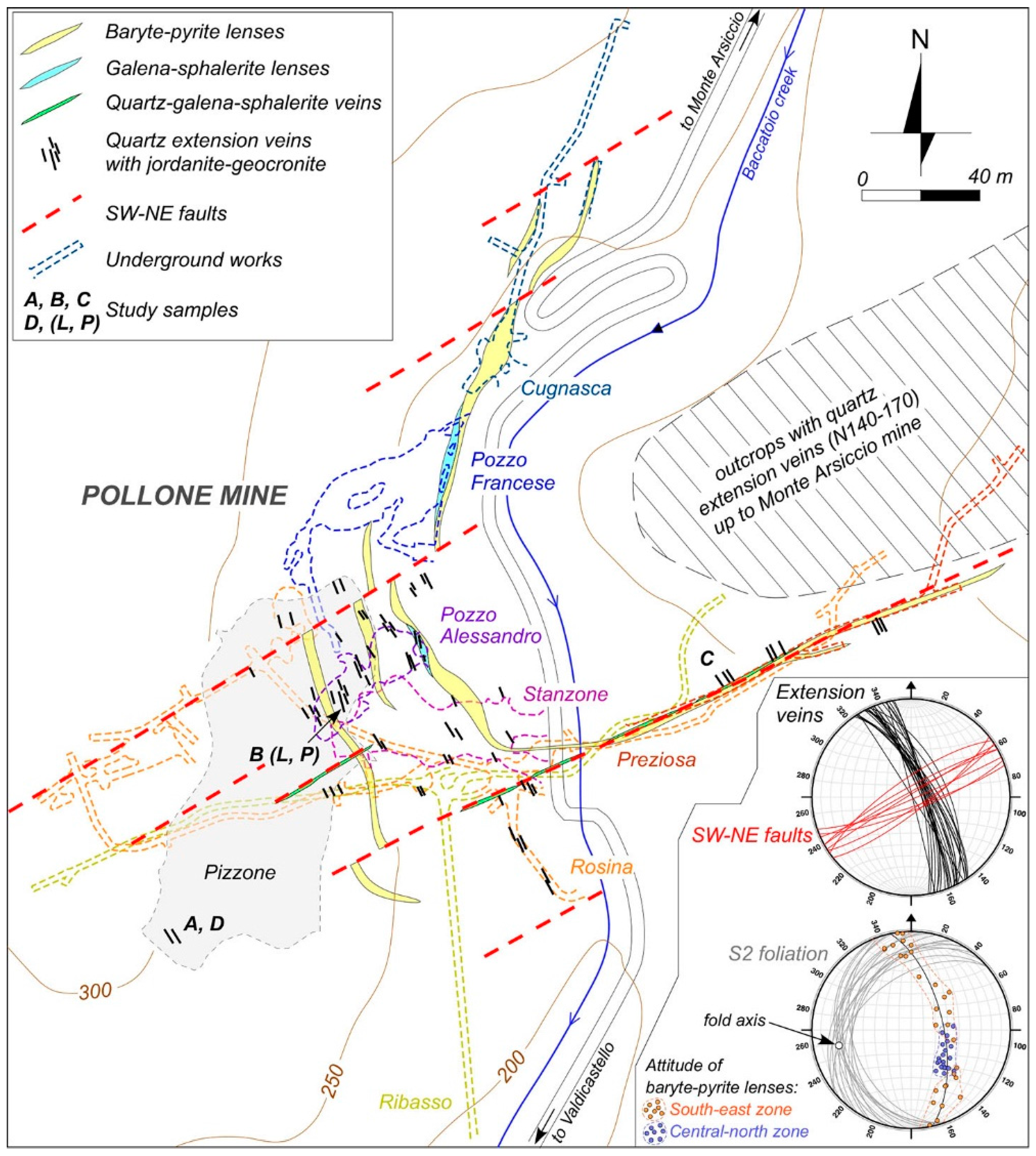
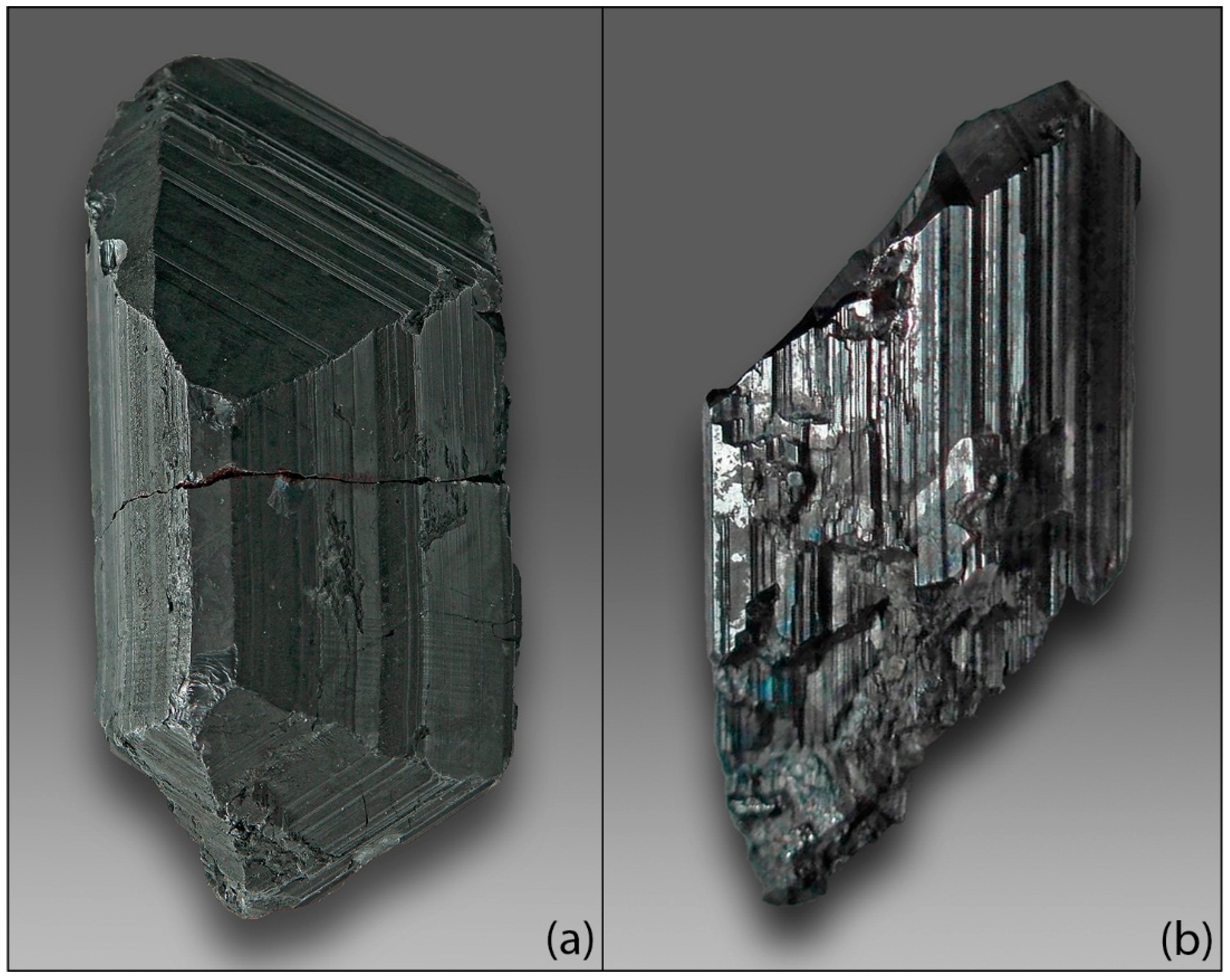
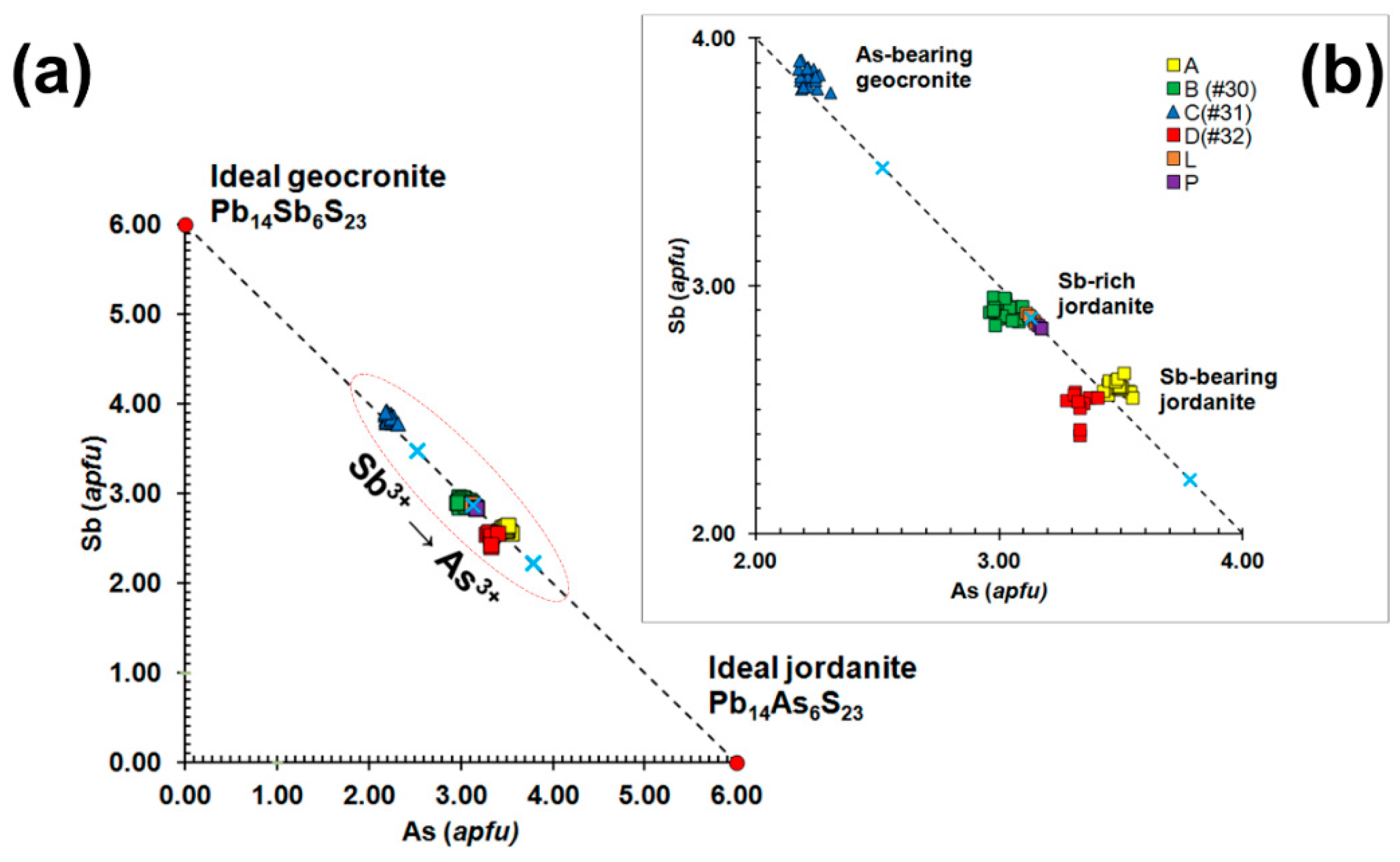
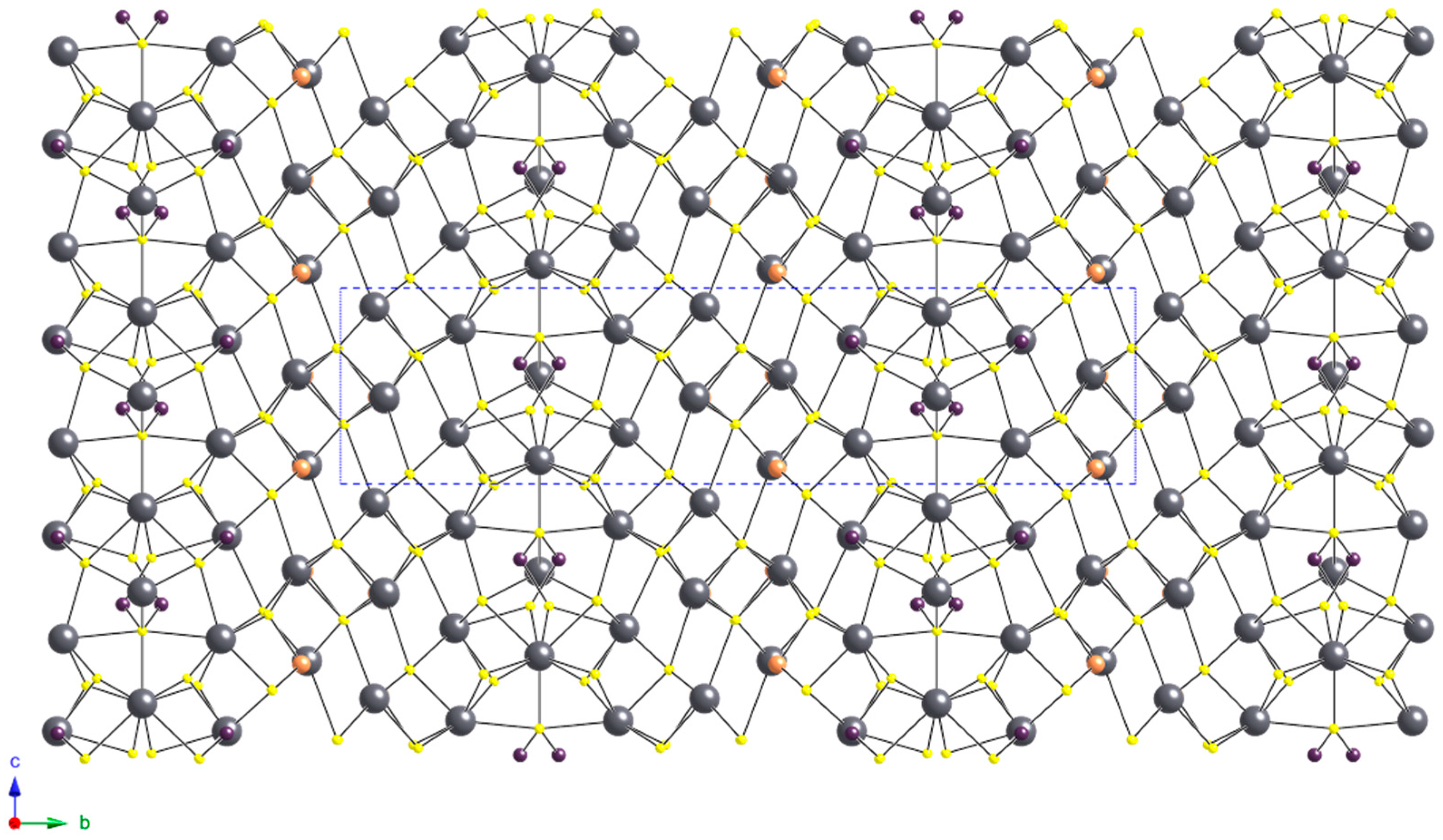
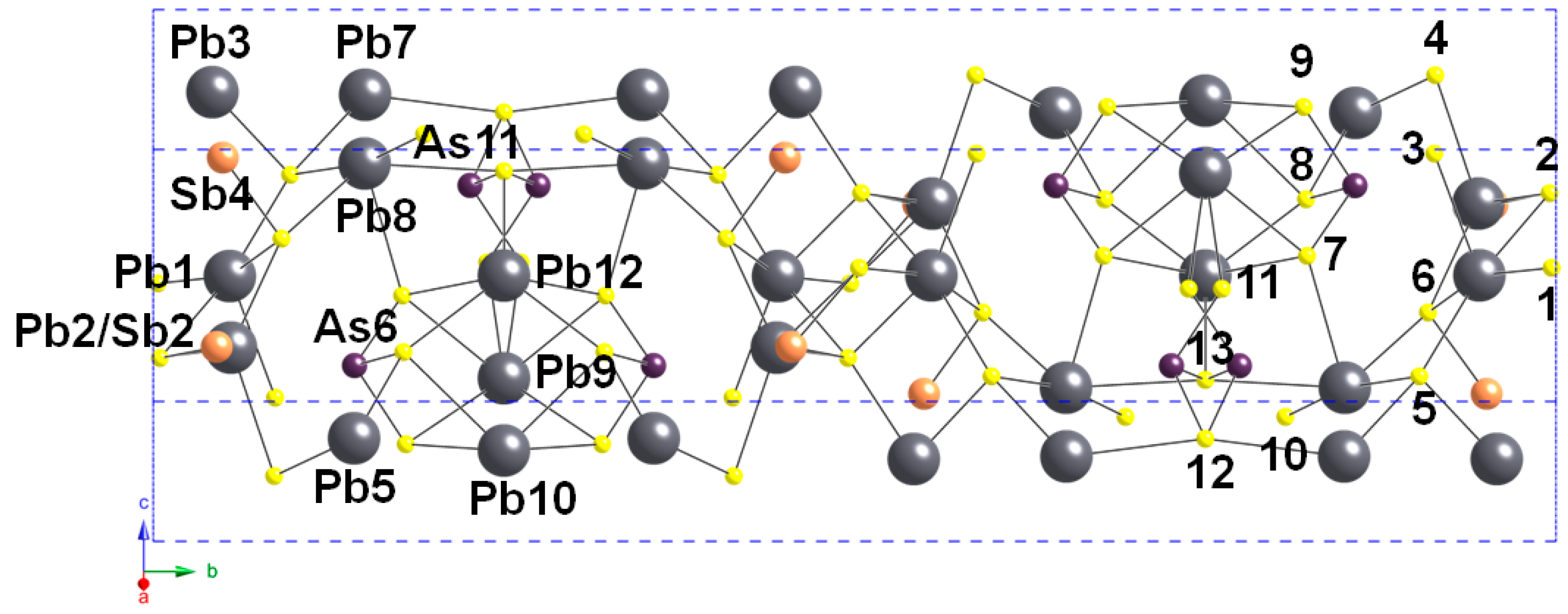
| Mineral | Chemical Formula | Mineral | Chemical Formula |
|---|---|---|---|
| Baumhauerite | Pb12As16S36 | Lopatkaite | Pb5Sb3AsS11 |
| Bernarlottiite | Pb6As5Sb3S18 | Madocite | Pb19(Sb,As)16S43 |
| Boulangerite | Pb5Sb4S11 | Marumoite | Pb32As40S92 |
| Dufrénoysite | Pb2As2S5 | Plagionite | Pb5Sb8S17 |
| Fülöppite | Pb3Sb8S15 | Robinsonite | Pb4Sb6S13 |
| Geocronite | Pb14(Sb,As)6S23 | Sartorite | PbAs2S4 |
| Gratonite | Pb9As4S15 | Semseyite | Pb9Sb8S21 |
| Guettardite | Pb8(Sb0.56As0.44)16S32 | Tsugaruite | Pb4As2S7 |
| Heteromorphite | Pb7Sb8S19 | Twinnite | Pb(Sb0.63As0.37)2S4 |
| Jordanite | Pb14(As,Sb)6S23 | Veenite | Pb2(Sb,As)2S5 |
| Liveingite | Pb20As24S56 | Zinkenite | Pb9Sb22S42 |
| Label | Description | Occurrence/Stope |
|---|---|---|
| A | Lead-gray, striated, prismatic crystals up to 5 mm in length, from a pocket | Type-1/Pizzone |
| B (#30) | Lead-gray crystals, up to 1 cm in size, from a pocket | Type 2/Pozzo Alessandro |
| C (#31) | Lead-gray crystals embedded in quartz + baryte vein | Type-3/Preziosa |
| D (#32) | Lead-gray compact veinlet | Type-1/Pizzone |
| L | Well-developed dipyramidal crystal. Historical specimen #14798 | Type-2 (?)/Unknown |
| P | Large deeply striated crystal. Historical specimen #14786 | Type-2 (?)/Unknown |
| Element | A (n = 20) | B (n = 20) | C (n = 20) | D (n = 10) | L (n = 6) | P (n = 4) | ||||||
|---|---|---|---|---|---|---|---|---|---|---|---|---|
| Mean | Σ | Mean | Σ | Mean | Σ | Mean | Σ | Mean | Σ | Mean | Σ | |
| Pb | 67.66 | 0.34 | 68.73 | 0.27 | 67.42 | 0.28 | 68.66 | 0.20 | 68.66 | 0.31 | 68.89 | 0.20 |
| As | 6.15 | 0.07 | 5.34 | 0.08 | 3.90 | 0.06 | 5.88 | 0.08 | 5.54 | 0.04 | 5.65 | 0.04 |
| Sb | 7.44 | 0.07 | 8.35 | 0.12 | 11.01 | 0.15 | 7.21 | 0.19 | 8.27 | 0.06 | 8.20 | 0.06 |
| Bi | 0.33 | 0.05 | 0.35 | 0.03 | 0.47 | 0.03 | 0.38 | 0.05 | - | - | - | - |
| S | 17.51 | 0.12 | 17.50 | 0.15 | 17.55 | 0.16 | 17.80 | 0.11 | 17.68 | 0.06 | 17.64 | 0.13 |
| Cl | - | - | - | - | - | - | - | - | 0.03 | 0.02 | 0.02 | 0.01 |
| Total | 99.08 | 0.42 | 100.26 | 0.33 | 100.35 | 0.37 | 99.93 | 0.29 | 100.18 | 0.33 | 100.40 | 0.30 |
| apfu | ||||||||||||
| Pb | 13.86 | 0.04 | 14.02 | 0.05 | 13.84 | 0.04 | 14.07 | 0.07 | 14.01 | 0.09 | 13.98 | 0.06 |
| As | 3.49 | 0.03 | 3.01 | 0.04 | 2.21 | 0.03 | 3.33 | 0.03 | 3.13 | 0.02 | 3.17 | 0.01 |
| Sb | 2.59 | 0.02 | 2.90 | 0.03 | 3.85 | 0.04 | 2.52 | 0.06 | 2.87 | 0.02 | 2.83 | 0.01 |
| Bi | 0.07 | 0.01 | 0.07 | 0.01 | 0.10 | 0.01 | 0.08 | 0.01 | - | - | - | - |
| S | 23.17 | 0.20 | 23.06 | 0.24 | 23.28 | 0.24 | 23.57 | 0.20 | 23.32 | 0.11 | 23.13 | 0.27 |
| Cl | - | - | - | - | - | - | - | - | 0.03 | 0.02 | 0.02 | 0.01 |
| Ev(%) | −0.4 | 0.9 | −0.3 | 1.0 | −0.9 | 1.0 | −2.6 | 0.9 | −1.4 | 0.5 | −0.7 | 0.9 |
| As/(As + Sb + Bi) | 0.567 | 0.003 | 0.504 | 0.004 | 0.360 | 0.005 | 0.562 | 0.007 | 0.521 | 0.002 | 0.528 | 0.001 |
| Crystal Data | Sb-Bearing Jordanite | Sb-Rich Jordanite | As-Bearing Geocronite |
|---|---|---|---|
| X-Ray formula | Pb14(As3.78Sb2.22)S23 | Pb14(As3.20Sb2.80)S23 | Pb14(Sb3.46As2.54)S23 |
| Crystal size (mm3) | 0.160 × 0.065 × 0.045 | 0.250 × 0.150 × 0.150 | 0.150 × 0.140 × 0.040 |
| Cell setting, space group | Monoclinic, P21/m | ||
| a (Å) | 8.9338(8) | 8.9554(3) | 8.9720(6) |
| b (Å) | 31.891(3) | 31.9228(11) | 31.9535(22) |
| c (Å) | 8.4720(8) | 8.4937(3) | 8.4888(6) |
| β (°) | 117.943(1) | 117.981(1) | 117.964(4) |
| V (Å3) | 2132.3(3) | 2144.3(1) | 2149.5(3) |
| Z | 2 | 2 | 2 |
| Data collection and refinement | Sb-bearing jordanite | Sb-rich jordanite | As-bearing geocronite |
| Radiation, wavelength (Å) | Mo Kα, λ = 0.71073 | ||
| Temperature (K) | 293 | ||
| 2θmax (°) | 65.07 | 65.14 | 65.00 |
| Measured reflections | 27,684 | 26,879 | 29,406 |
| Unique reflections | 7756 | 7674 | 7852 |
| Reflections with Fo > 4σ (Fo) | 6231 | 5394 | 5751 |
| Rint | 0.0350 | 0.0672 | 0.0697 |
| Rσ | 0.0327 | 0.0707 | 0.0640 |
| Range of h, k, l | −12 ≤ h ≤ 13 −42 ≤ k ≤ 48 −12 ≤ l ≤ 12 | −13 ≤ h ≤ 13 −48 ≤ k ≤ 45 −12 ≤ l ≤ 12 | −13 ≤ h ≤ 13 −47 ≤ k ≤ 48 −12 ≤ l ≤ 12 |
| R [Fo > 4σ (Fo)] | 0.0332 | 0.0687 | 0.0782 |
| R (all data) | 0.0467 | 0.0970 | 0.1053 |
| wR (on F2) | 0.0777 | 0.1840 | 0.2012 |
| GooF | 1.048 | 1.094 | 1.133 |
| Number of l.s. parameters | 216 | 217 | 216 |
| Maximum and minimum | 4.23 (at 0.73 Å from Pb9) | 5.66 (at 0.85 Å from Pb8) | 8.15 (at 0.92 Å from Pb12) |
| residuals (e/Å3) | −3.83 (at 0.50 Å from Pb12) | −5.85 (at 0.75 Å from Pb3) | −4.89 (at 0.76 Å from Pb1) |
| Site | Sb-Bearing Jordanite | Sb-Rich Jordanite | As-Bearing Geocronite | |||
|---|---|---|---|---|---|---|
| s.o.f. | <Me–S> | s.o.f. | <Me–S> | s.o.f. | <Me–S> | |
| Pb1 | Pb1.00 | 2.993 | Pb1.00 | 2.996 | Pb1.00 | 2.997 |
| Pb2a/Sb2b | Pb0.50Sb0.50 | 2.928/2.576 | Pb0.50Sb0.50 | 2.932/2.583 | Pb0.50Sb0.50 | 2.933/2.588 |
| Pb3 | Pb1.00 | 3.011 | Pb1.00 | 3.016 | Pb1.00 | 3.014 |
| Sb4 | Sb0.61(1)As0.39(1) | 2.407 | Sb0.84(2)As0.16(2) | 2.448 | Sb0.98(2)As0.02(2) | 2.464 |
| Pb5 | Pb1.00 | 3.047 | Pb1.00 | 3.053 | Pb1.00 | 3.054 |
| As6 | As1.00 | 2.253 | As0.94(2)Sb0.06(2) | 2.263 | As0.75(2)Sb0.25(2) | 2.296 |
| Pb7 | Pb1.00 | 3.034 | Pb1.00 | 3.037 | Pb1.00 | 3.039 |
| Pb8 | Pb1.00 | 3.028 | Pb1.00 | 3.032 | Pb1.00 | 3.035 |
| Pb9 | Pb0.50 | 3.074 | Pb0.50 | 3.073 | Pb0.50 | 3.078 |
| Pb10 | Pb0.50 | 3.075 | Pb0.50 | 3.079 | Pb0.50 | 3.079 |
| As11 | As0.50 | 2.211 | As0.50 | 2.221 | As0.50 | 2.225 |
| Pb12 | Pb0.50 | 3.023 | Pb0.50 | 3.023 | Pb0.50 | 3.017 |
© 2016 by the authors; licensee MDPI, Basel, Switzerland. This article is an open access article distributed under the terms and conditions of the Creative Commons by Attribution (CC-BY) license (http://creativecommons.org/licenses/by/4.0/).
Share and Cite
Biagioni, C.; Dini, A.; Orlandi, P.; Moëlo, Y.; Pasero, M.; Zaccarini, F. Lead-Antimony Sulfosalts from Tuscany (Italy). XX. Members of the Jordanite–Geocronite Series from the Pollone Mine, Valdicastello Carducci: Occurrence and Crystal Structures. Minerals 2016, 6, 15. https://doi.org/10.3390/min6010015
Biagioni C, Dini A, Orlandi P, Moëlo Y, Pasero M, Zaccarini F. Lead-Antimony Sulfosalts from Tuscany (Italy). XX. Members of the Jordanite–Geocronite Series from the Pollone Mine, Valdicastello Carducci: Occurrence and Crystal Structures. Minerals. 2016; 6(1):15. https://doi.org/10.3390/min6010015
Chicago/Turabian StyleBiagioni, Cristian, Andrea Dini, Paolo Orlandi, Yves Moëlo, Marco Pasero, and Federica Zaccarini. 2016. "Lead-Antimony Sulfosalts from Tuscany (Italy). XX. Members of the Jordanite–Geocronite Series from the Pollone Mine, Valdicastello Carducci: Occurrence and Crystal Structures" Minerals 6, no. 1: 15. https://doi.org/10.3390/min6010015
APA StyleBiagioni, C., Dini, A., Orlandi, P., Moëlo, Y., Pasero, M., & Zaccarini, F. (2016). Lead-Antimony Sulfosalts from Tuscany (Italy). XX. Members of the Jordanite–Geocronite Series from the Pollone Mine, Valdicastello Carducci: Occurrence and Crystal Structures. Minerals, 6(1), 15. https://doi.org/10.3390/min6010015







